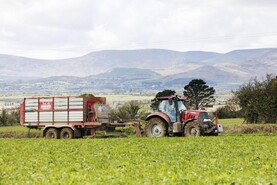The De Laval VMS V300 is the next Voluntary Milking System on the market available from the 27th of June. The product was launched on various pilot farms. The Irish Farmers Journal attended one of the launches in Bantega, the Netherlands which has used a VMS V300 since January.
The focus of the VMS V300 is to increase production per cow. Three key areas were targeted when designing the V300, cluster attachment, milk circulation and user friendliness.
Attachment
Using new insight technology, the new machine can milk 3,500kg per day verses 3,000kg for the existing VMS model. The camera has been changed to detect teats from one metre away. This allows for more efficient preparation. The attachment is now 50% faster taking between 60 and 80 seconds
Two spray nozzles on the arm allow for a pre- and post- spray. The spray targets the ends of the teats, aiming to reduce the amount of chemicals used by up to 20%. According to Jonas Hallman, head of milking systems at De Laval, the robot can milk up to 9.2 times per hour. This means the machine has a capability of milking 70 cows three times a day.
Milk Circulation
The new robot has better vacuum stability and water consumption is reduced by 18% with De Laval's new pure flow system. There is also less distance for the milk to travel to the collecting jar. Energy consumption in the new robot is 10-15% lower in the VMS V300.
Service
The V 300 is easily serviced. Greater accessibility by service technicians allows two units to be serviced in one day. The service packages starting from .9c/l of milk produced but vary depending on the needs of the system.
The price of a V 300 varies depending on market conditions. From 2019 the V300 will be the standard robot sold to De Laval customers.
The Opti Duo
The secondary product was launched called the OptiDuo, the machine allows feed to be refreshed and accessed by cows 24/7. Head of feed systems Ludo Bois said, “This technology will provide uniform feeding for cows with 24hr access to roughage.” The product can be used for grass, silage and TMR feeding.

OptiDuo uses an auger to push the forage towards the feed barrier while refreshing and mixing the feed.
An auger is used to push feed towards the feed barrier. It runs along wire in the ground. There are four settings allowing the robot to adjust according to how much feed is present.
The machine has increased DM intake by 5-10%.
“It gives peace of mind and frees up time”, according to Ten Kate a farmer present at the launch. It requires six hours of uninterrupted charging every 24hrs.
Read more
Technical Innovation Award winners
Farming at your fingertips
The De Laval VMS V300 is the next Voluntary Milking System on the market available from the 27th of June. The product was launched on various pilot farms. The Irish Farmers Journal attended one of the launches in Bantega, the Netherlands which has used a VMS V300 since January.
The focus of the VMS V300 is to increase production per cow. Three key areas were targeted when designing the V300, cluster attachment, milk circulation and user friendliness.
Attachment
Using new insight technology, the new machine can milk 3,500kg per day verses 3,000kg for the existing VMS model. The camera has been changed to detect teats from one metre away. This allows for more efficient preparation. The attachment is now 50% faster taking between 60 and 80 seconds
Two spray nozzles on the arm allow for a pre- and post- spray. The spray targets the ends of the teats, aiming to reduce the amount of chemicals used by up to 20%. According to Jonas Hallman, head of milking systems at De Laval, the robot can milk up to 9.2 times per hour. This means the machine has a capability of milking 70 cows three times a day.
Milk Circulation
The new robot has better vacuum stability and water consumption is reduced by 18% with De Laval's new pure flow system. There is also less distance for the milk to travel to the collecting jar. Energy consumption in the new robot is 10-15% lower in the VMS V300.
Service
The V 300 is easily serviced. Greater accessibility by service technicians allows two units to be serviced in one day. The service packages starting from .9c/l of milk produced but vary depending on the needs of the system.
The price of a V 300 varies depending on market conditions. From 2019 the V300 will be the standard robot sold to De Laval customers.
The Opti Duo
The secondary product was launched called the OptiDuo, the machine allows feed to be refreshed and accessed by cows 24/7. Head of feed systems Ludo Bois said, “This technology will provide uniform feeding for cows with 24hr access to roughage.” The product can be used for grass, silage and TMR feeding.

OptiDuo uses an auger to push the forage towards the feed barrier while refreshing and mixing the feed.
An auger is used to push feed towards the feed barrier. It runs along wire in the ground. There are four settings allowing the robot to adjust according to how much feed is present.
The machine has increased DM intake by 5-10%.
“It gives peace of mind and frees up time”, according to Ten Kate a farmer present at the launch. It requires six hours of uninterrupted charging every 24hrs.
Read more
Technical Innovation Award winners
Farming at your fingertips







 This is a subscriber-only article
This is a subscriber-only article












SHARING OPTIONS: